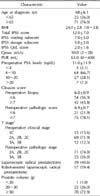1. Boorjian SA, Eastham JA, Graefen M, Guillonneau B, Karnes RJ, Moul JW, et al. A critical analysis of the long-term impact of radical prostatectomy on cancer control and function outcomes. Eur Urol. 2012; 61:664–675.

2. Moran PS, O'Neill M, Teljeur C, Flattery M, Murphy LA, Smyth G, et al. Robot-assisted radical prostatectomy compared with open and laparoscopic approaches: a systematic review and meta-analysis. Int J Urol. 2013; 20:312–321.

3. Kim TH, Han DH, Lee KS. The prevalence of lower urinary tract symptoms in Korean men aged 40 years or older: a population-based survey. Int Neurourol J. 2014; 18:126–132.

4. Resnick MJ, Barocas DA, Morgans AK, Phillips SE, Chen VW, Cooperberg MR, et al. Contemporary prevalence of pretreatment urinary, sexual, hormonal, and bowel dysfunction: Defining the population at risk for harms of prostate cancer treatment. Cancer. 2014; 120:1263–1271.

5. Masters JG, Rice ML. Improvement in urinary symptoms after radical prostatectomy: a prospective evaluation of flow rates and symptom scores. BJU Int. 2003; 91:795–797.

6. Lepor H, Kaci L. The impact of open radical retropubic prostatectomy on continence and lower urinary tract symptoms: a prospective assessment using validated self-administered outcome instruments. J Urol. 2004; 171:1216–1219.

7. Slova D, Lepor H. The short-term and long-term effects of radical prostatectomy on lower urinary tract symptoms. J Urol. 2007; 178:2397–2400.

8. Giannantoni A, Mearini E, Zucchi A, Costantini E, Mearini L, Bini V, et al. Bladder and urethral sphincter function after radical retropubic prostatectomy: a prospective long-term study. Eur Urol. 2008; 54:657–664.

9. Van Kerrebroeck P, Andersson KE. Terminology, epidemiology, etiology, and pathophysiology of nocturia. Neurourol Urodyn. 2014; 33:Suppl 1. S2–S5.

10. Schneider T, de la Rosette JJ, Michel MC. Nocturia: a nonspecific but important symptom of urological disease. Int J Urol. 2009; 16:249–256.

11. Marshall SD, Raskolnikov D, Blanker MH, Hashim H, Kupelian V, Tikkinen KA, et al. International Consultations on Urological Diseases. Nocturia: current levels of evidence and recommendations from the international consultation on male lower urinary tract symptoms. Urology. 2015; 85:1291–1299.
12. Matsubara A, Yoneda T, Yasumoto H, Teishima J, Shiina H, Igawa M, et al. Lower urinary tract symptoms after radical perineal prostatectomy. Jpn J Clin Oncol. 2007; 37:534–539.

13. Namiki S, Saito S, Ishidoya S, Tochigi T, Ioritani N, Yoshimura K, et al. Adverse effect of radical prostatectomy on nocturia and voiding frequency symptoms. Urology. 2005; 66:147–151.

14. Homma Y, Kawabe K, Tsukamoto T, Yamaguchi O, Okada K, Aso Y, et al. Estimate criteria for diagnosis and severity in benign prostatic hyperplasia. Int J Urol. 1996; 3:261–266.

15. Prabhu V, Taksler GB, Sivarajan G, Laze J, Makarov DV, Lepor H. Radical prostatectomy improves and prevents age dependent progression of lower urinary tract symptoms. J Urol. 2014; 191:412–417.

16. Choi WS, Ku JH, Oh SJ, Kim SW, Paick JS. Change of nocturnal polyuria after holmium laser enucleation of the prostate in patients with benign prostatic hyperplasia. Urology. 2014; 84:650–656.

17. Gordon A, Skarecky DW, Ahlering T. Long-term outcomes in severe lower urinary tract symptoms in men undergoing robotic-assisted radical prostatectomy. Urology. 2014; 84:826–831.

18. Tikkinen KA, Auvinen A, Johnson TM 2nd, Weiss JP, Keränen T, Tiitinen A, et al. A systematic evaluation of factors associated with nocturia: the population-based FINNO study. Am J Epidemiol. 2009; 170:361–368.
19. De Ridder D, Roumeguère T, Kaufman L. Urgency and other lower urinary tract symptoms in men aged ≥ 40 years: a Belgian epidemiological survey using the ICIQ-MLUTS questionnaire. Int J Clin Pract. 2015; 69:358–365.
20. Kayali M, Balci M, Aslan Y, Bilgin O, Guzel O, Tuncel A, et al. The relationship between prostate cancer and presence of metabolic syndrome and late-onset hypogonadism. Urology. 2014; 84:1448–1452.

21. Hutchinson RC, Thiel DD, Tavlarides AM, Diehl NN, Parker AS. The effect of robot-assisted laparoscopic prostatectomy on nocturia. J Endourol. 2012; 26:861–865.










 PDF
PDF ePub
ePub Citation
Citation Print
Print


 XML Download
XML Download